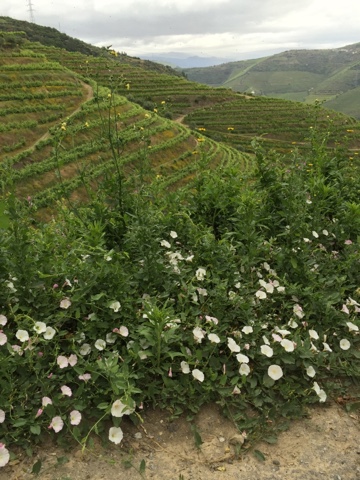Tuesday, June 14, 2016
We started the day at breakfast with a treat from Robert -- a pastry that is a specialty of Coimbra - pastel de Tentugal, a flaky puff pastry with a sweet egg filling and a dusting of powdered sugar. Delicious.
We boarded the bus at 8:30 and headed for the Douro Valley. Since it was about a 3 hour drive, we made a brief rest stop for "cafe com leite". The trip took us high into the 5,000 ft. Serrado Marao mountain range that guards the region -- creating a micro climate that is perfect for growing grapes. Temperature variations range from snowy winters to hot, arid summers, which apparently is good for wine grapes.
Coming down from the mountains into the valley was truly picturesque. The hills are covered with terraced vineyards, each owned by a specific company, or Quinta.
Today we visited Quinta Sta Eufemia, another family-owned farm. Although it has been in the family for generations, it is now run by a sister (also the master taster), a brother, and a sister-in-law, who gave us the tour. (That's the farm in the background.)
We walked in their vineyards and were given an informative talk about the plants.
If we had come in September or October, we could have been part of this process.
The juice from the grapes is then filtered from the seeds and skins through this metal filter. Apparently this is much better than by machine. Some wineries use "robots," but they break the seeds and the stems, causing the wine to be bitter.Then she showed us the oak barrels where the wine is stored and the bottling facility.
Afterwards she gave us a crash course in how their port is made. Port is a medium sweet wine (20% alcohol). It is fortified with grape brandy, sometimes called "grappa" at a ratio of 4-1. The introduction of the brandy kills the yeast, halting the fermentation process, and leaving more sugar in the port. Port makers constantly monitor sugar levels to attain the sweetness they want. Port only ferments for 2-3 days (standard wines ferment 10-12 days) before aging in wood or bottles, anywhere from 2 years to longer than a century.
Following our tour, we were treated to wines and lunch on the farm. We started off with 3 different types of port: white, a young port made with white grapes; ruby, a young red aged about 3 years; and tawny, the most typical version associated with port which is aged 10-40 years. Then we also sampled white and red wines made on the farm. Needless to say, everything was wonderful.
Then back on the bus for the drive to our hotel in Pinhão, about an hour away. The scenery along the way continued to be beautiful.
We walked around town a little, but there is not much else here. The only unique feature is an old railway station with wonderful tiles.
We could see our hotel, The Vintage House Hotel on the right as we crossed the Douro River.
The hotel was amazing -- 4-star luxury in the middle of nowhere. I have to post pictures because it was so unbelievable. All our rooms looked out over the Douro River. Tonight we had dinner at the hotel, which was incredibly elegant. We were wowed. Too bad it is only for one night.


















No comments:
Post a Comment